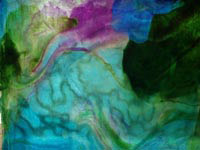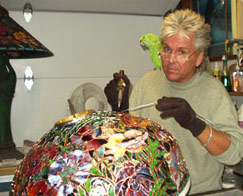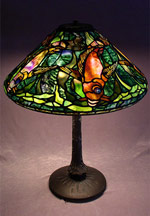One Man Show
- Home
- Reviews
One Man Show
By Robert Kendrick
 Sometime in the early 1980’s a man sits on the floor of his garage trying to put together two sections of a lampshade. His hands are desperately preoccupied with the task of soldering the pieces together while he tries to hold the two sections together with nothing less than his feet. The man: Scott Riggs; the shade: Scott’s first Tiffany reproduction lamp. “I felt like a little monkey,” remembers Riggs with a chuckle, after several unsuccessful attempts to get the piece together properly and several burns to his feet, Riggs ended the night throwing both the shade and the soldering iron across the room at the garage door.
Sometime in the early 1980’s a man sits on the floor of his garage trying to put together two sections of a lampshade. His hands are desperately preoccupied with the task of soldering the pieces together while he tries to hold the two sections together with nothing less than his feet. The man: Scott Riggs; the shade: Scott’s first Tiffany reproduction lamp. “I felt like a little monkey,” remembers Riggs with a chuckle, after several unsuccessful attempts to get the piece together properly and several burns to his feet, Riggs ended the night throwing both the shade and the soldering iron across the room at the garage door.
Little did Scott know that Tiffany reproduction lamps would eventually become his life’s work and greatest passion. Like most lamp makers Riggs started first creating stained glass windows, while he’s self-taught, he was introduced to the art through a friend.
“I had a friend that knew I could draw,” remembers Riggs of his first encounter with stained glass windows, “He asked me to draw him a sailboat in such a way that he could use it as a pattern for a stained glass window. Then I watched him cut out the glass and next thing I know I was picking up the scrap glass off his floor so I could go home and make my own stuff, and I kind of just went on from there.”
“I started making little windows, then big windows and pretty soon people saw what I was doing and I started getting orders for windows.” This eventually led him to experiment with making lampshades. “I found that it was a lot easier to make shades and sell them than make windows and sell them.”
“I started looking at all kinds of books that had any kind of Tiffany work in it and I started doing Tiffany reproductions, but I’d do it my own way with my own colors and style.”
One of the first pattern books Riggs used was published over twenty years ago by World Art Glass Quarterly’s own publisher Mark Walton. “I learned how to make my first roses from that book,” says Riggs. Walton has since turned into an ardent admirer of Scott’s work.
“The thing that makes him so unique,” explains Walton, “is that he makes accurate Tiffany Lamps, but his color choice is amazing, he’s got a really great eye for color.”
“I don’t necessarily try to follow Tiffany’s color schemes,” says Riggs, “I like to experiment with the background and border glass, but you’ve got to have a flow to it all.” This mentality is very apparent in his work, while Riggs often uses bold colors that are very striking, they are always used in context as to preserve the “flow” of the overall piece.
As most glass artists will agree no two sheets of glass are the same, colors have a unique way of swirling and blending differently when the glass is fabricated. Riggs spends a good deal of his time looking through countless sheets of glass in order to find what’s perfect for each individual shade. “There’s some great glass out there, but you gotta know how to use it,” Riggs explains, “Sometimes I tear up a whole sheet of glass just to get to a small part of it where the color’s just right.”
“I’m very picky,” says Riggs, “Everything has to be perfect.” Scott’s perfectionism has brought him all sorts of customers from around the world.
“Most of my clients have owned Tiffany lamps at some point in their lives and then found out they could make a profit by selling them,” explains Riggs, “Now their kicking themselves for having ever sold their shades in the first place and want to reproduce the pieces they used to own. People will come in wishing they had never sold their Daffodil [shade] and I’ll tell them ‘okay well let’s make you a new Daffodil.’”
“Once they buy that first shade,” continues Riggs, “They’ll usually buy more, I have a lot of repeat customers.” Customers then refer friends who then refer friends so that most of Scott’s advertising is done primarily by word-of-mouth. “I’m working with a woman in Michigan right now who just ordered her fourteenth shade,” explains Riggs; this customer came by way of referral.
“They usually approach me with an idea,” says Scott, “Some will want me to match certain colors, but some, like this lady in Michigan will let me have free reign and trust my judgment.” Riggs can make about 80 different lamp patterns each can take anywhere from 30 to 250 hrs. No matter how many orders come in Scott still makes them one shade at a time and alone.
“I’ve taught a few people and helped some make their own lamps, but I’ve never had assistants, I’m a one man show!” says Riggs. His reasoning for working alone is twofold. The first because he believes that in order to make his shades right, the way he envisions the end product he must be the artist from start to finish.
 There are many factories throughout the world churning out mass-produced Tiffany-style lamps and then there are a few small studios like that of Scott Riggs meticulously recreating every detail Tiffany intended on a lamp by lamp basis. While there is no great evil with the former it should never be confused with the latter. “There’s only a handful of us out there making these lamps the right way… that tape each piece perfectly and reinforce correctly,” explains Riggs.
There are many factories throughout the world churning out mass-produced Tiffany-style lamps and then there are a few small studios like that of Scott Riggs meticulously recreating every detail Tiffany intended on a lamp by lamp basis. While there is no great evil with the former it should never be confused with the latter. “There’s only a handful of us out there making these lamps the right way… that tape each piece perfectly and reinforce correctly,” explains Riggs.
The second reasoning for the way he works is that Scott has a passion and energy for lamp making that shines through in every conversation. “I wake up every morning and love going into work,” he says, “I get to go in and make these lamps and I literally have to force myself to stop at night, because otherwise I’d just work all night. I love what I do.”
Whatever frustration he may have felt that night making his first lamp has long since been crushed by the love he’s acquired for these lampshades. He’s been recreating Tiffany shades for nearly thirty years and harbors no doubt that he will be making these shades for another thirty. “There’s always kind of a mystery about the future,” says Scott, “You never know if customers will keep buying these things or what, however I’m not going anywhere I’m going to keep making these things till I’m dead.”
Read More Reviews and Articles
 The artistry captured and expressed by Scott Riggs is of museum quality and he will create a personal art treasure to be admired and appreciated by all who are fortunate enough to share in its beauty and historical value. A lamp masterfully created by Scott will indeed be a treasure to be handed down from family generation to generation. As with Louis Comfort Tiffany, Scott too desires to add grace and beauty to every home at very affordable prices. If you would like to own a one of a kind, extraordinary custom created treasure of art to grace your home or office, contact him with your specifications.
The artistry captured and expressed by Scott Riggs is of museum quality and he will create a personal art treasure to be admired and appreciated by all who are fortunate enough to share in its beauty and historical value. A lamp masterfully created by Scott will indeed be a treasure to be handed down from family generation to generation. As with Louis Comfort Tiffany, Scott too desires to add grace and beauty to every home at very affordable prices. If you would like to own a one of a kind, extraordinary custom created treasure of art to grace your home or office, contact him with your specifications.